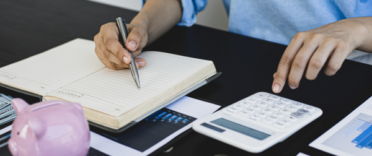How much can you make from a buy-to-let property?

Buy-to-let investment has mushroomed over recent years with the high demand for rental property and changes to pension rules fuelling the rise in popularity. Many see property investment as a route to riches, with ever-increasing house prices and rents providing a steady income and capital appreciation from their investment.
If you are considering purchasing a buy-to-let property then you need to understand the costs and the likely return on your investment, together with the risks involved. In this article I aim to answer these questions and hopefully give a clear idea of how much you can make from a buy-to-let investment.
How much is a typical mortgage for a buy-to-let investment?
I have decided to use a case study to illustrate the initial outlay in terms of deposit and mortgage for a buy-to-let investment, the details of which are as follows:
Purchase price: £160,000
Deposit: £40,000
Mortgage amount: £120,000
Mortgage deal: 2-year fixed-rate mortgage with Platform at 1.71% on an interest-only basis over 25 years (reverting to standard variable rate of 5% after the initial 2-year period)
Monthly payment: £171
This deal was found using our best-buy mortgage comparison tool, powered by Habito*. The details are correct at the time of writing.
What rental income can I get from a buy-to-let investment?
The income you can expect from your buy-to-let investment will vary depending on the type of property you buy and the area in which you buy. The average UK rental yield is around 3.63%, although that overall figure masks significant regional variations, with yields below 3% in some parts of London and more than 5% for selected areas in the North East.
For the purposes of my case study, I am going to use an annual rental yield of 4.0%, which means the rental income from my case study property will be £6,400 per annum, which will be subject to income tax.
What costs are there for a buy-to-let property?
One-off mortgage and purchase costs
Mortgage fees: The lender fees for Platform are £199. Fees with other lenders could be up to £2,000
Survey fees: Approximately £500
Legal fees: Approximately £700
Stamp duty: £5,500 (including additional property surcharge of 3% on £160,000 purchase price)
Regular costs
Mortgage repayments: - £2,052 p.a (£171 p.m)
Loss of interest received on £40,000 deposit @ 1% per annum - £320 p.a. (net of 20% income tax)
Letting agent fees: Approximately 12% of rental income - £768 p.a.
Landlord & rental insurance: Approximately £960 p.a.
Estimated repairs: £500 p.a.
Estimated void period rental loss: £500 p.a.
Total costs
Total monthly costs (including mortgage): £5,100 p.a.
Additional costs for buying the property: £6,899
How to calculate the annual rental yield
Annual rental yield (C) is calculated by taking the annual rental income less annual costs (A) and dividing it by the purchase price of the property plus related costs (B).
So, in the case of our case study:
A - Net rental income = £6,400 - £5,100 = £1,300 p.a.
B - Total cost of purchasing property = £160,000 + £6,899= £166,899
C - Annual rental yield = 0.8%
How much capital growth will I get from my buy-to-let property?
Over the past 10 years (2005 - 2020) the average house price in the UK has increased by around 35%. If I assume that house price increases will move in line with the last 10 years once the price inflation driven by the pandemic has subsided, then our case study property will increase in value from £150,000 in 2020 to £202,500 in 2030. This is equivalent to an annual capital growth of 3.5%.
How much will I pay in tax on my buy-to-let investment?
Proceeds from all buy-to-let investments are subject to taxation. Rental income (less some allowances) is subject to Income Tax at the individual's marginal rate. As from 6th April 2020 tax relief for mortgage costs will be restricted to the basic rate of income tax, currently 20% and will be treated as a reduction in tax liability rather than a reduction in taxable rental income. Buy-to-let properties are also subject to capital gains tax (CGT). This is charged at a rate of 28% (for higher-rate taxpayers) or 18% (basic-rate taxpayers) on any growth in the value of the property.
If you're a basic rate taxpayer, bear in mind that the gain will be added to your income, so this could push you into a higher-rate band. Everyone has a tax-free capital gains allowance of £12,300 per year in 2021-22, so you'll only need to pay CGT on profits above this threshold. It's also possible to offset some costs, such as what you paid out for stamp duty and conveyancing when you bought the property and any charges associated with selling it (including estate agent fees). You should also be able to offset any capital improvements you've made to the property against your CGT bill. You're not allowed to deduct outgoings on the upkeep of the property or mortgage interest.
For more information, read our article: "How will your rental income be taxed? Everything you need to know".
How much can I make from a buy-to-let investment - summary
In the case study above the total return in the first year would be:
- 0.7% in rental yield
- 3.5% in capital growth
This equates to 4.2% gross total return on the investment before taxation. Bear in mind that you won't enjoy the capital growth until you actually sell the property.
As you can see from the case study if you experience high repair costs or long void periods your investment could be costing you money on a monthly basis. There are also upfront costs in buying the property of £6.899 which in our cases study would wipe out the first 12 months rental income.
The conclusion is that if you are investing in buy-to-let financed via a mortgage then monthly net rental income is likely to negligible at best. You would the be relying on capital growth to achieve a return on your investment. However a buy-to-let investment without the need for a mortgage can provide both a monthly income and capital growth over time.
Note:
- The above calculations assume that a 25% deposit is available and the balance of the purchase price is secured with a mortgage
- All costs are estimates and a may be lower or higher
- House price growth figures are for the whole of the UK and may be lower or higher in specific locations
If a link has an * beside it this means that it is an affiliated link. If you go via the link Money to the Masses may receive a small fee which helps keep Money to the Masses free to use. But as you can clearly see this has in no way influenced this independent and balanced review of the product. The following link can be used if you do not wish to help Money to the Masses - Habito






Given you are including the cost of borrowing in your calculations I think it is disingenuous to exclude the benefits of leveraging by borrowing.
In your example the investor starts with £30,000 deposit in 2005 and buys a property for £150,000. Then in 2015 he would sell for £184,000 and pay off the £120,000 mortgage, leaving him with £64,000. So this is a return of over 113% on his £30,000 in 10 years pre-tax and pre-costs, not 24%. Unless there is something I’m missing here?
Glyn,
Thanks very much for your comment and you are correct that the return on the original investment in my example would be 113%. Bear in mind that that return figure is a function of leveraging and not solely a function of the underlying asset. As such a figure of 113% could well be used in a positive spin for leveraging rather than for investing in buy-to-let property as an asset.
One of the main attractions with buy-to-let investment is the ease in which you can leverage your investment and can offset the borrowing costs by renting the property. However, using leverage in any investment is not just a one way street and any fall in the value of the asset can have a catastrophic effect on the value of your original investment. For example average house prices in the UK fell 18% between Q3 2007 and Q1 2009 which would have wiped out nearly all the original deposit in my example. Average house prices did not return to their 2007 value until Q2 2014. If you were unlucky enough to invest in buy-to-let during this period you would not be able to realise your investment without incurring a loss for a period of 7 years.
Another thing to bear in mind is that the initial costs of purchasing a buy-to-let investment are quite high, particularly if you have leveraged your investment by way of a mortgage. In my example the upfront costs are £3,500 and with a rental income of £684 p.a. it would take over 5 years to recoup these costs.
The aim of this article was throw some figures into the buy-to-let discussion so that potential investor have more information at their disposal to help them in their investment decisions.
Thanks once again your contribution to this discussion, please keep in touch.
—
Given you are taking into account the mortgage costs, the annual rental yield figure should be on a ‘cash’ basis rather than on the total value. In year 1, you receive £684 net rent on an expenditure of £33550 giving a fraction over 2% return. With the capital growth this would make 4.4% return
Ian,
Thanks very much for your comments and I do agree that there is an alternative way of looking at annual rental yield. However, to be consistent Liam decided to use the same methodology as used in the ‘LSL Property Services Buy-to-let Index’ referred to in the paragraph headed ‘Rental Income’.